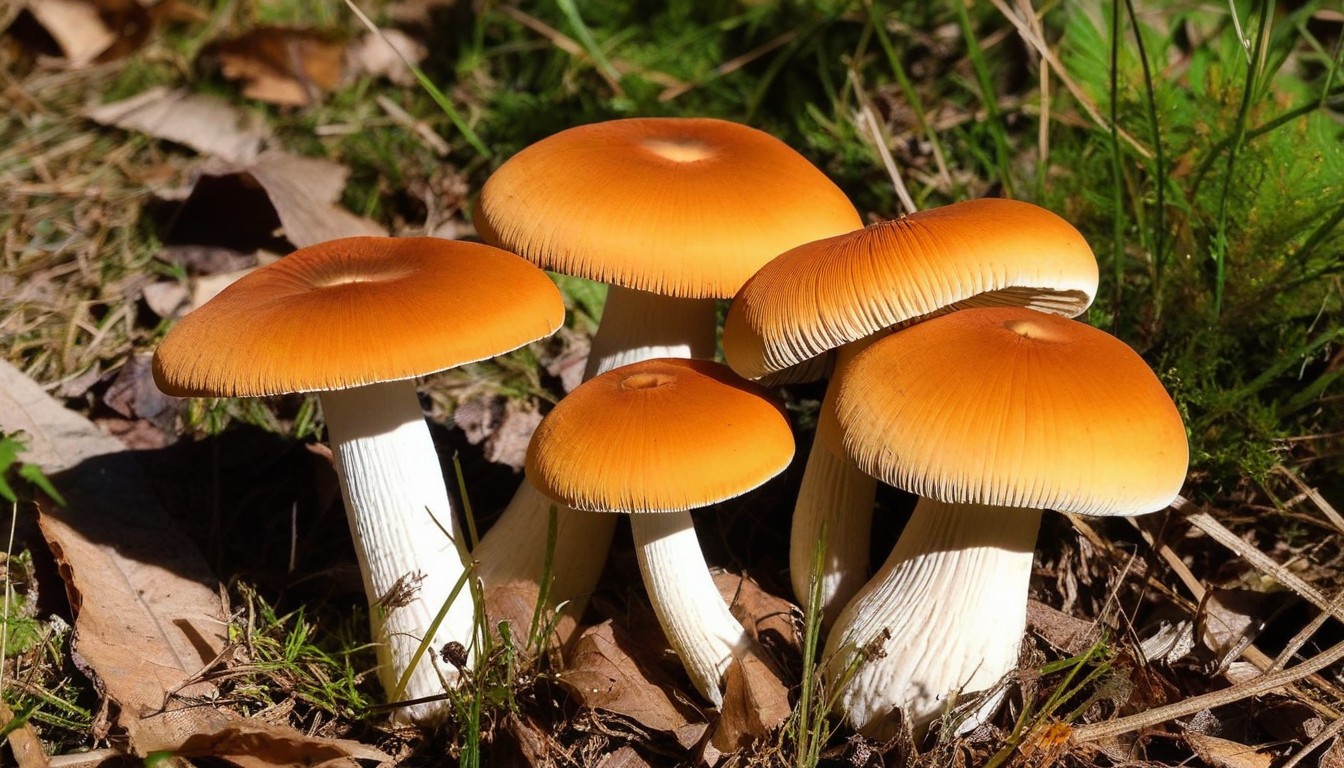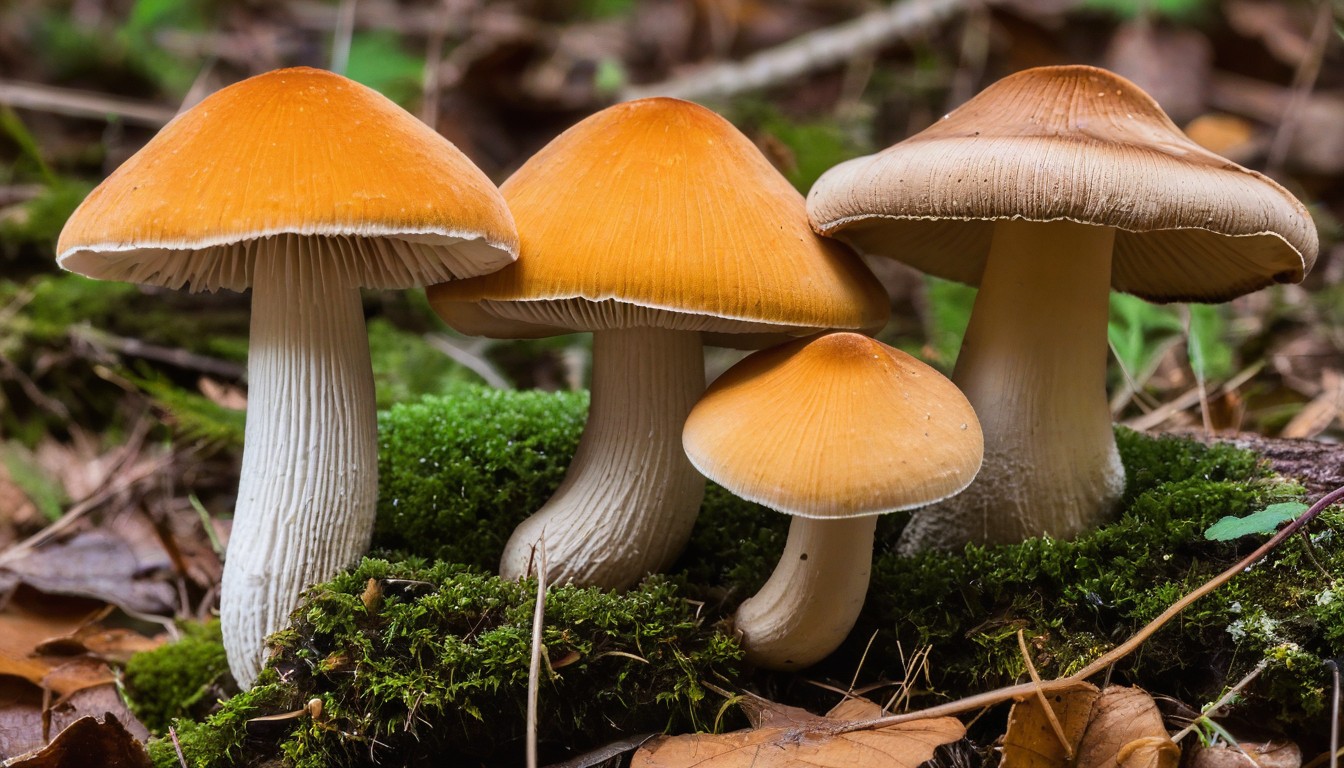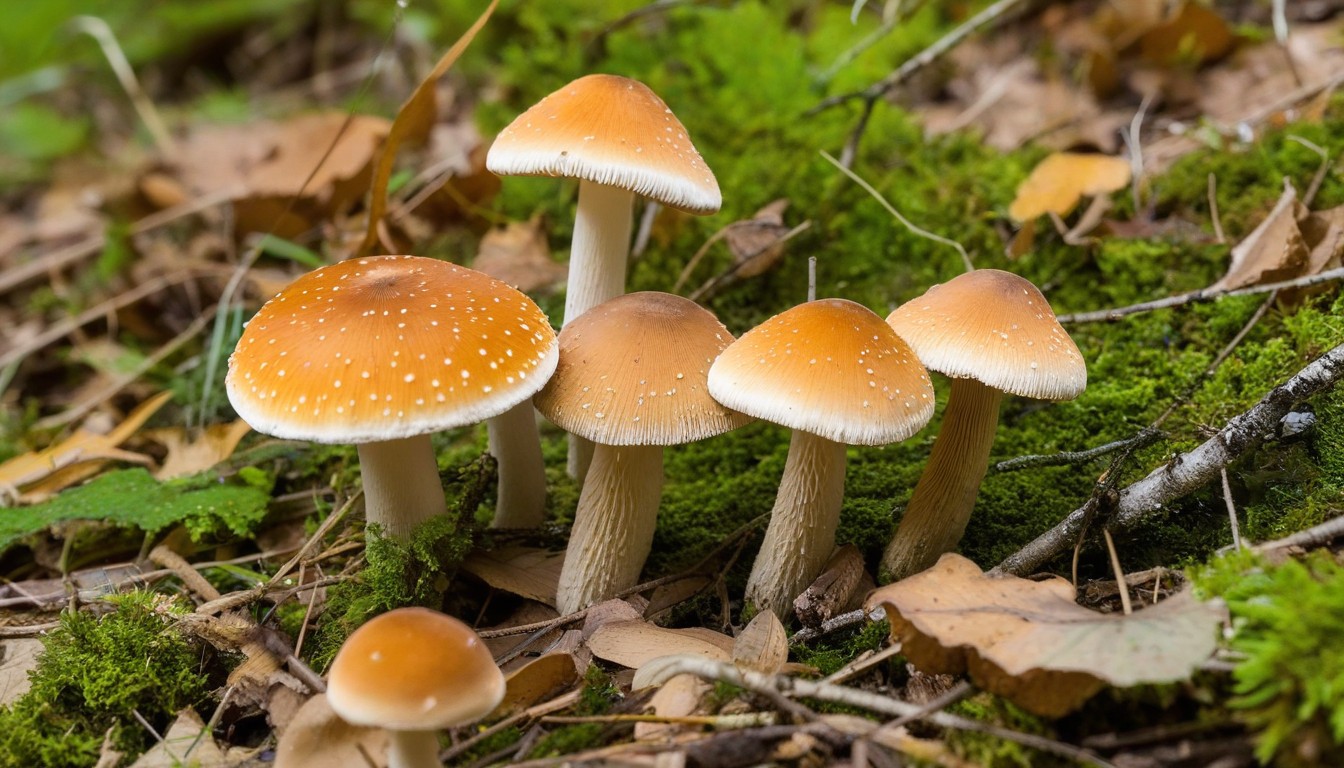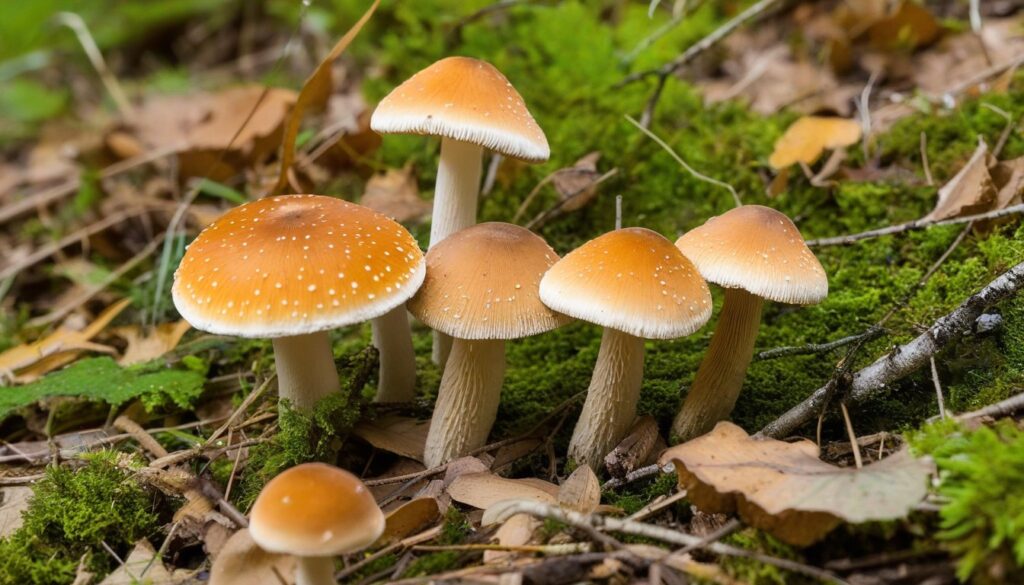Are you interested in learning more about the fascinating world of mushrooms? Look no further than Indiana, where a wide variety of common mushroom species can be found right in your own backyard. Whether you’re an avid nature enthusiast or curious beginner, this guide will provide you with the knowledge and tools needed to identify mushrooms with ease.
Key Takeaways:
- Indiana is home to a multitude of common mushroom species.
- With the help of this guide, you can confidently identify different types of mushrooms.
- Understanding mushroom anatomy is crucial to accurate identification.
- Be sure to differentiate between edible and poisonous mushrooms.
- Some mushrooms found in Indiana also have medicinal properties.
Introduction to Mushrooms
Have you ever spotted a mushroom growing in your backyard and wondered about its identity? Maybe you’ve heard of the dangers of eating wild mushrooms and want to learn how to identify them. Either way, before we dive into identifying specific mushrooms found in Indiana, it’s helpful to have a general introduction to mushrooms.
Mushrooms are fascinating organisms that come in a wide variety of shapes, sizes, and colors. They’re different from plants in that they don’t have chlorophyll and can’t generate energy through photosynthesis. Instead, they obtain nutrients from the organic matter they grow on. Mushrooms are an essential part of ecosystems and play critical roles in breaking down plant and animal matter to recycle nutrients back into the soil.
There are various types of mushrooms, with the two most common categories being edible and poisonous. Some mushrooms are even medicinally beneficial and have been used for centuries in traditional medicine.
Before we delve into the specifics of identifying mushrooms, it’s essential to understand some basic terminology. Mushrooms have a distinctive anatomy, with common parts, including the cap, stem, gills, and spores. Knowing these parts’ names and functions is crucial to accurately identifying and classifying mushrooms.
The Different Types of Mushrooms
There are thousands of different types of mushrooms, but they can generally be categorized into three groups:
- Saprophytic mushrooms: These mushrooms break down dead plant matter and recycle it back into the ecosystem.
- Parasitic mushrooms: These mushrooms grow on plants and trees and obtain nutrients from living hosts.
- Mycorrhizal mushrooms: These mushrooms form a symbiotic relationship with the roots of plants, exchanging essential nutrients and water.
Each type of mushroom has unique characteristics that distinguish it from the others. Getting to know these differences and common traits is an important step in identifying mushrooms.
Mushroom Anatomy

Understanding mushroom anatomy is essential in correctly identifying different types of mushrooms. Each part of a mushroom serves a specific purpose and plays a crucial role in its classification. Here are the key parts of a mushroom you need to know:
|
Part |
Description |
|---|---|
|
CAP |
The top part of the mushroom that can vary in shape, size, color, and texture. Caps can have different features, such as scales, warts, and bumps. |
|
STEM |
The stem, also known as the stalk, supports the cap and contains the spores. The stem can have various shapes, colors, and textures. |
|
GILLS |
The gills, located on the underside of the cap, are thin, blade-like structures that vary in size and shape. The color of gills can differ and is an important identifying feature. |
|
SPORES |
The spores are the reproductive cells of the mushroom and are usually found on the gills or other specialized structures. Spore color is a key factor in identifying mushrooms. |
In general, it’s important to consider the color, texture, smell, and context of a mushroom when attempting to identify it. Become familiar with the different parts of a mushroom and their significance, and you’ll be able to successfully distinguish different types of mushrooms.
Mushroom Identification Techniques

Identifying mushrooms can be challenging as there are many species with similar characteristics. However, proper techniques and observation can make the task easier. Here are some tips for mastering the art of mushroom identification:
- Observe Physical Characteristics: Look closely at the cap, stem, gills, and spores, noting colors, textures, shapes, and sizes. Take note of any unique features, such as a ring or veil on the stem or a distinctive odor.
- Use Field Guides: Bring a mushroom identification guide with you on your nature walks. These guides often include detailed descriptions and illustrations to help you identify mushrooms in the field.
- Make Spore Prints: Spore prints can help determine the color of the mushroom’s spores, which can aid in identification. Place the cap of the mushroom on a piece of paper or glass overnight to make a spore print.
Remember, never eat mushrooms that are not positively identified as safe to consume by an expert. Some poisonous mushrooms can look similar to edible species, making accurate identification crucial to your safety. With these techniques and a keen eye for detail, you’ll be able to confidently identify common mushrooms in no time!
Edible Mushrooms in Indiana

If you’re looking to add some variety to your meals, why not try incorporating some of Indiana’s edible mushrooms into your dishes? Here are a few of the most common edible mushrooms found in Indiana:
|
Mushroom |
Distinctive Features |
Culinary Uses |
|---|---|---|
|
Morel |
Distinct honeycomb-like cap |
Often sautéed and served as a side dish or used in sauces and gravies. |
|
Chicken of the Woods |
Bright yellow-orange cap with no gills |
Often used as a meat substitute and added to stir fry or soups. |
|
Chanterelle |
Distinctive trumpet shape with a vibrant yellow-orange color |
Often used in sauces, soups, and risottos. |
These are just a few examples of the many edible mushrooms found in Indiana. Before consuming any mushroom, be sure to properly identify it and consult a local expert to ensure it is safe for consumption.
Note: Remember that wild mushrooms can be unpredictable and potentially dangerous if not correctly identified. It is essential to confirm the mushroom’s identity before ingestion.
Poisonous Mushrooms in Indiana
While mushrooms can be a tasty addition to any cuisine, it’s crucial to know which mushrooms are safe to eat. In Indiana, there are several types of poisonous mushrooms that you should avoid. These mushrooms are known for their toxic effects on the body, which can range from mild to severe.
Types of Poisonous Mushrooms
Some of the common poisonous mushrooms in Indiana include:
|
Mushroom Name |
Toxic Effects |
Physical Attributes |
|---|---|---|
|
Death Cap |
Liver failure, kidney failure, and death |
Greenish-yellow cap, white stem, and white gills that don’t turn brown with age |
|
Destroying Angel |
Liver failure, kidney failure, and death |
White cap, white gills, and a white stem with a bulbous base |
|
Galerina Marginata |
Liver failure and death |
Brownish-orange cap, rusty brown gills, and a thin stem |
It’s not always easy to identify these poisonous mushrooms, as they can look similar to edible mushrooms. Therefore, it’s essential to observe their physical attributes and understand the signs of toxicity.
Signs of Mushroom Poisoning
If you accidentally ingest a poisonous mushroom, it’s crucial to seek medical attention immediately. Symptoms of mushroom poisoning can vary depending on the type of mushroom and the amount ingested, but they may include:
- Nausea and vomiting
- Diarrhea
- Abdominal pain
- Sweating
- Difficulty breathing
- Loss of consciousness
Always remember to only consume mushrooms that you’re confident are safe for consumption. When in doubt, it’s best to err on the side of caution and avoid consuming mushrooms that are unfamiliar to you.
Medicinal Mushrooms in Indiana

Did you know that certain types of mushrooms boast potent medicinal properties? These so-called medicinal mushrooms have been used for centuries in traditional Chinese medicine and are now gaining popularity in the Western world for their immune-boosting and anti-inflammatory abilities. Here are a few of the medicinal mushrooms found in Indiana and their potential health benefits:
|
Mushroom Name |
Potential Health Benefits |
|---|---|
|
Reishi |
Boosts immune system, reduces stress, lowers blood pressure |
|
Lion’s Mane |
Enhances cognitive function, promotes nervous system health |
|
Turkey Tail |
Improves gut health, strengthens immune system |
Keep in mind that while these mushrooms do hold potential health benefits, they should not be used as a substitute for medical treatment or as a cure for any disease. As always, it’s essential to consult with a healthcare professional before incorporating medicinal mushrooms into your diet or health routine.
That being said, next time you’re out on a mushroom hunt in Indiana, keep an eye out for some of these fascinating fungi and their unique properties.
Uncommon and Rare Mushrooms in Indiana
While many mushroom species are common in Indiana, others are rare and unique. These uncommon mushrooms have distinct features, and their ecological significance makes them a fascinating study. Let’s look at a few of these rare types.
|
Mushroom Name |
Distinctive Features |
Ecological Significance |
|---|---|---|
|
Amanita muscaria |
Bright red cap with white spots |
Important role in the mycorrhizal network that connects plant roots underground |
|
Phallus indusiatus |
Also known as the “Veiled Lady” due to its lacy skirt hanging from the cap |
Breaks down decaying organic matter and helps to recycle nutrients back into the environment |
|
Morchella americana |
Distinctive yellowish-brown, cone-shaped cap with ridges and hollow center |
Can indicate areas of disturbed soils or wildfire ecosystems |
These uncommon and rare mushrooms are just a few examples of the diverse fungal species found in Indiana. As you continue to explore and learn about mushrooms, you’ll discover even more fascinating and unique varieties.
Conclusion
Congratulations! You’ve now learned all you need to know about identifying common mushrooms in Indiana. We hope this guide has provided you with useful information and inspiration to explore the world of fungi. Remember, always practice caution when consuming mushrooms and consult an expert if you’re unsure about their edibility. As you continue to delve into the fascinating realm of mushrooms, keep in mind that there’s always more to discover and learn. Happy mushroom hunting!
FAQ
Can I use this guide to identify mushrooms in other states?
While this guide is specifically tailored for identifying common mushrooms in Indiana, many of the identification techniques and terminology can be applied to mushrooms found in other states as well.
Are all mushrooms with gills poisonous?
No, not all mushrooms with gills are poisonous. There are many edible mushrooms that have gills, but it’s important to properly identify the mushroom before consuming it to ensure it is safe for consumption.
Can I rely solely on visual characteristics to identify mushrooms?
Visual characteristics are a crucial part of mushroom identification, but they should not be the sole determining factor. It is recommended to use multiple identification techniques, such as spore prints and field guides, to increase accuracy.
How can I distinguish between a poisonous mushroom and an edible one?
Distinguishing between poisonous and edible mushrooms can be challenging. It is best to consult with an experienced mushroom forager or mycologist before consuming any wild mushrooms.
Are there any mushrooms in Indiana that have known medicinal properties?
Yes, there are several mushrooms in Indiana that have known medicinal properties. Some examples include reishi mushrooms, which are believed to boost the immune system, and turkey tail mushrooms, which have been studied for their potential anti-cancer effects.
Are rare mushrooms in Indiana endangered or protected?
Some rare mushrooms in Indiana may be endangered or protected due to their ecological significance. It is important to respect and preserve their natural habitats and consult local regulations before collecting or foraging rare mushrooms.

